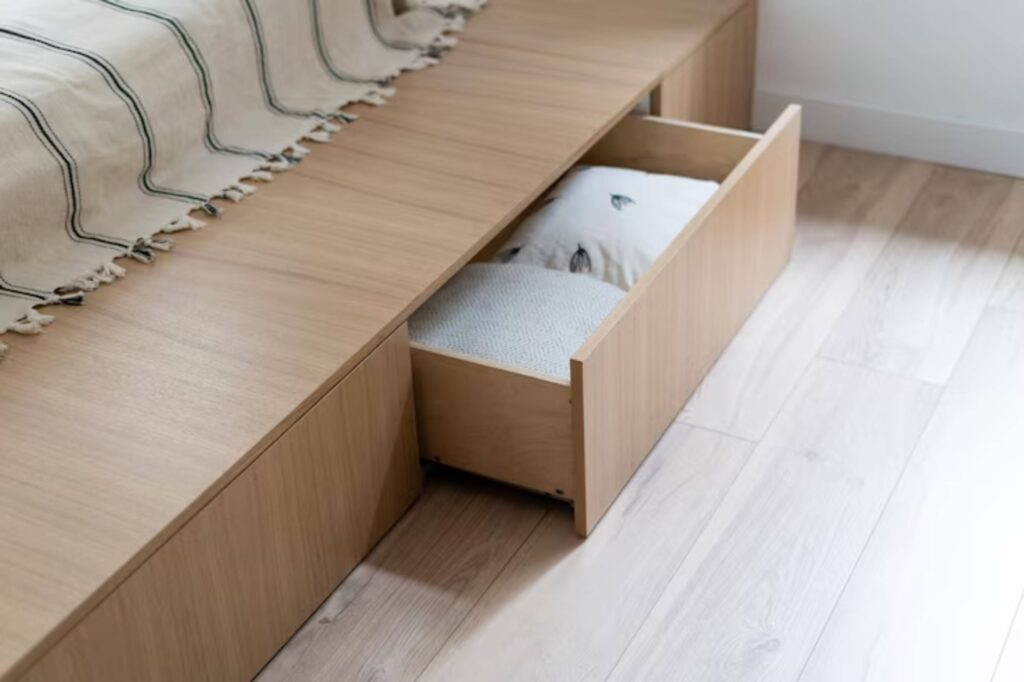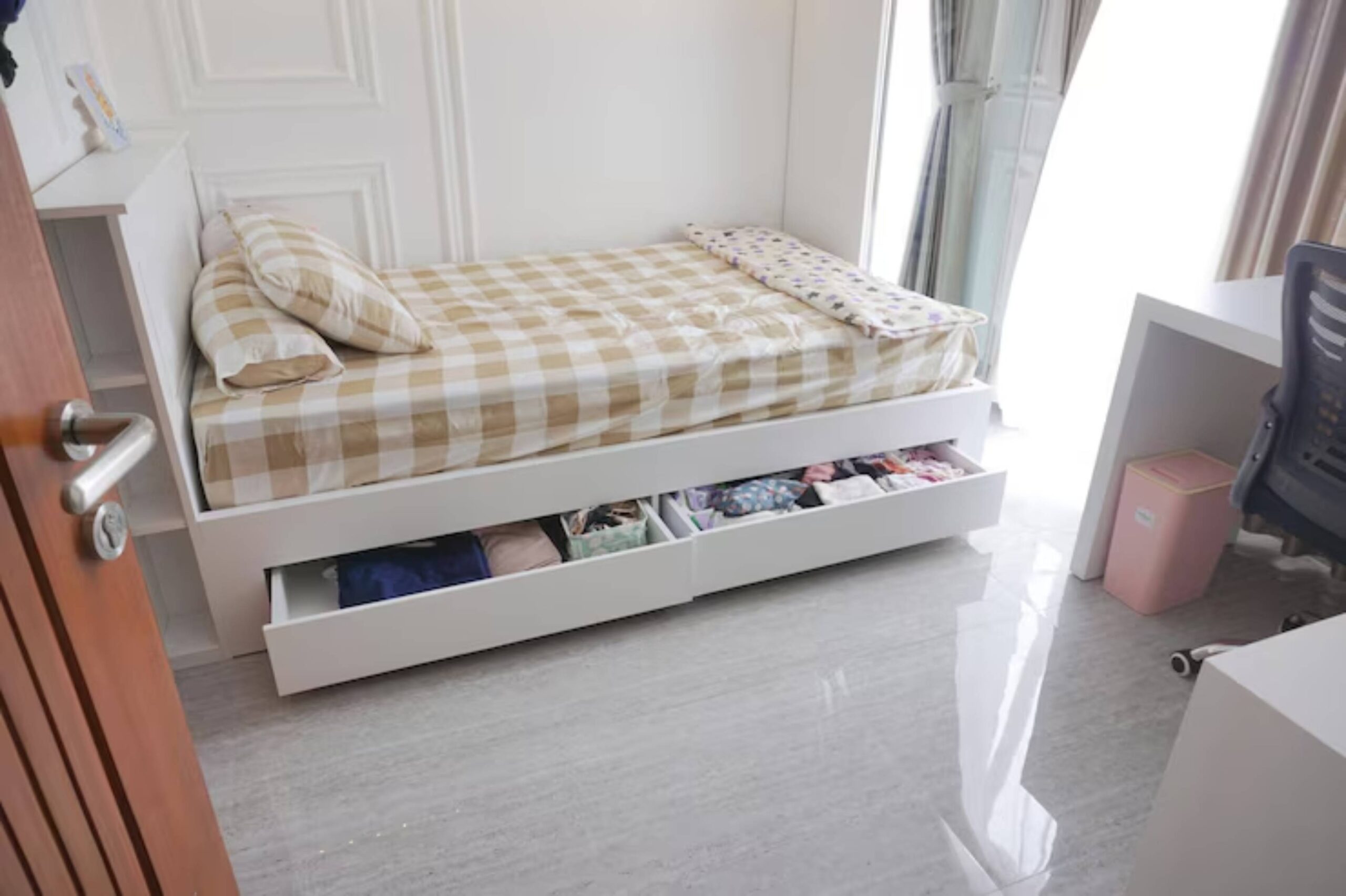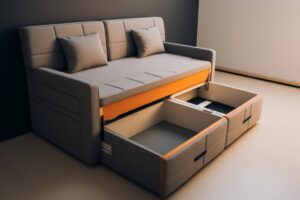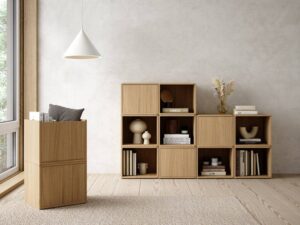The Interior Design Blog

How to Use Under-Furniture Space for Storage
In a small home, every inch matters. But while walls get shelves and cupboards overflow with containers, the space beneath your furniture often sits ignored. It’s time to change that.
Whether you’re living in a studio flat, a family home with limited closets, or just craving order in a cramped room, using under-furniture storage is one of the most effective, affordable, and renter-friendly ways to maximise space.
Let’s explore hidden space tips and creative small home storage ideas that don’t require renovations — just a shift in perspective.
Understanding the Core: Why Under-Furniture Storage Works
The floor space under beds, sofas, benches, and even chairs is prime real estate for the organised home. Most homes leave this space empty — often because it’s out of sight, or people simply don’t think to use it.
Here’s why it’s worth your attention:
- It’s the available space you already own
- It keeps your floor visually clear
- It works for items you don’t need daily access to
- It requires no drilling or structural changes
Interior designers agree: hidden storage makes your home feel calmer and more functional. And when done right, under-furniture storage is invisible to guests but indispensable to you.
Quick Guide: Under-Furniture Storage at a Glance

- Choose the furniture with enough clearance or hidden compartments.
- Sort items by frequency of use — store lesser-used ones underneath.
- Use bins, drawers, or rolling units that slide easily.
- Label and organise to avoid forgotten items.
- Use bed risers or sofa legs if you need more height.
- Stick to low-profile containers to keep the area tidy and dust-free.
- Review and rotate stored items seasonally.
Step-by-Step Guide: How to Practise Under-Furniture Storage
1. Evaluate Your Furniture for Usable Space
Not all furniture offers equal storage potential.
Check the clearance underneath your:
- Bed: Most beds offer 6–12 inches
- Sofa: Some models have 3–6 inches or built-in drawers
- TV console, bench, or sideboard Perfect for bins, books, or tech
- Coffee table: Consider baskets or boxes below
- Dining chairs or desks: Often overlooked for laptop or supply storage
Pro Tip: Use a flashlight or ruler to check what fits without dragging heavy furniture.
2. Measure the Space and Choose the Right Containers
The key is easy access and clean aesthetics.
Depending on height and width:
- Use rolling bins for deep under-bed space
- Opt for flat zippered bags for seasonal clothes or linens
- Try canvas baskets under benches or tables
- Use slim drawer units for office supplies under desks
Make sure they’re easy to slide out and clean underneath.
3. Declutter and Sort Before Storing
Don’t shove everything under the bed and hope for the best.
Be intentional:
- Group items by use (e.g. seasonal clothes, gift wrap, backup toiletries)
- Only store items you don’t need daily
- Avoid food or anything with scent — it attracts pests
Important: Wipe down containers and label clearly so you can rotate items seasonally.
4. Use Risers or Furniture with Built-In Storage
Short clearance? Lift it.
- Bed risers can add up to 8 inches of storage height
- Furniture with hidden compartments (like lift-top coffee tables or storage benches) keeps things concealed
- Add wheels to crates or use drawer inserts for easier access
If you’re building from scratch or buying new furniture, opt for dual-purpose pieces, just like those in convertible furniture ideas for small apartments.
Read: How to Create a Functional Entryway in a Shoebox Apartment.
5. Maintain and Rotate Stored Items
It’s easy to forget what you’ve hidden.
- Do a seasonal check every 3–4 months
- Replace clothing sachets or silica packets to keep stored items fresh
- Dust regularly around bins and vacuum if under beds or sofas
Important: Avoid placing heavy storage in high-traffic walkways — especially under chairs or footpaths, where stubbing toes becomes a real hazard.
Best Practices & Additional Insights
The Lifestyle Angle: Living Lighter and Smarter
Small-space living is about editing down and building up efficiency. Under-furniture storage supports minimalist living without sacrificing access or convenience.
Pairing Storage with Design Aesthetics
Just because it’s hidden doesn’t mean it has to be ugly. Match baskets to your decor palette. Use wooden crates under rustic furniture or clean, white boxes in modern spaces.
Consider pairing your strategy with ideas like decorative storage that doubles as home decor to merge function and style seamlessly.
FAQs

Is under-furniture storage safe for long-term use?
Yes — as long as the area is dry, free from pests, and checked periodically. Avoid storing perishable or valuable items long-term.
What’s the best way to keep dust from collecting under furniture?
Use closed bins with lids, vacuum regularly, and choose containers with wheels or feet to allow airflow.
Can I store shoes under furniture?
Absolutely. Use shallow shoe bins or divided boxes. Just ensure shoes are clean and dry before storing.
What’s the best use of under-bed storage?
Seasonal clothing, spare linens, out-of-season décor, or low-use electronics like spare chargers or cables.
Is it okay to store things under sofas and chairs?
Yes, if the height allows, and it doesn’t block air circulation. Low-profile bins work best.
Ready to Unlock the Hidden Storage in Your Home?
You don’t need more space — you need to see the space you already have differently. With a few smart choices and a little organisation, under furniture storage can change the way your home functions. It’s invisible to the eye but essential for peaceful, clutter-free living.
Start small — look under one piece of furniture today, and ask: what could I store here that would free up room somewhere else? That’s where your transformation begins.









